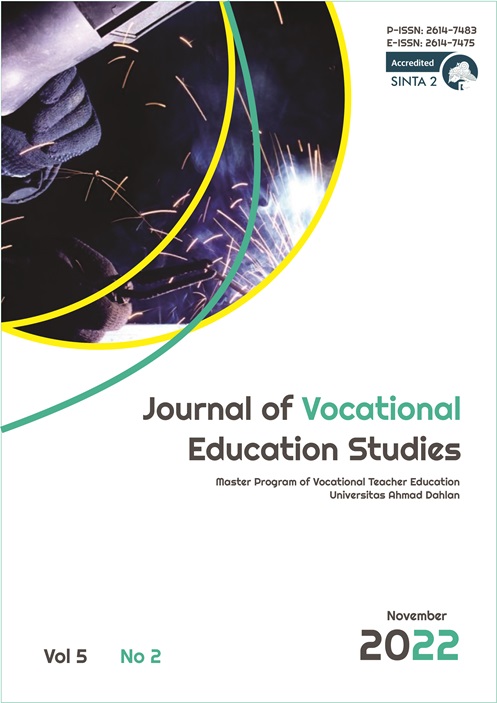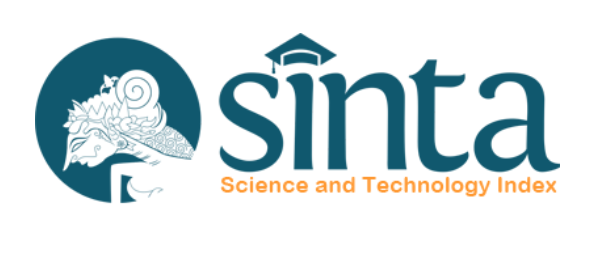Development of Worksheets on Creative Product Learning and Entrepreneurship in Indonesia’s Vocational Education & Training Schools
DOI:
https://doi.org/10.12928/joves.v5i2.6895Keywords:
PBSAS, Entrepreneurship, VET School.Abstract
This research is a research and development (R & D) that aims to analyse and develop Problem-Based Student Activity Sheets/PBSAS using android in the subjects of Creative Products Learning and Entrepreneurship (CPLE) in Vocational Education & Training/VET School that meets the proper and effective requirements. The development of PBSAS using the ADDIE model includes analysing, designing, developing, implementing, and evaluating. Research location conducted at VET School Negeri 2 Cilacap with sample study participant educate XI level majoring in Mechanical Engineering (27 participants educate), with type study experiment, one group pretest-posttest design. retrieval technique sample that is simple random sampling. Data analysis techniques are carried out qualitative and quantitative. Analysis qualitative conducted to results related to observations and interviews with analysis needs. Whereas analysis quantitative was conducted on data on the feasibility and effectiveness of PBSAS on CPLE lessons in VET School. PBSAS implementation of CPLE lessons at VET School is not yet in accordance with the hope, because students still experience confusion on PBSAS instructions that have not been clear. PBSAS was developed served in google slide form, students could work on the PBSAS to edit it on the slide shared by the teacher and containing material in the form of animated videos. PBSAS on CPLE lessons at VET School has high effectiveness, demonstrated with the value of N Gain score is 0.749 and strong.
References
Arends, RI (Ed.) (2013). Learning to teach (9 ed. Vol. 2): McGraw-Hill Education (Asia) and Salemba Empat.
Arestu, OO, Karyadi, B., & Ansori, I. (2018). Improved problem-solving skills through student activity sheets (PBSAS). Diklabio: Journal of Biology Education and Learning, 2 (2), 58-66.
Ashori, M., Firdaus, AR, Arinati, Zaenuddin, HM, Hendrawan, B., Widiyastuti, H., & Antoni, C. (2017). Entrepreneurial character education : Andi Publisher.
BPS. (2021). Statistics official news . Jakarta: BPS
Branch, RM (2009). Instructional design: the ADDIE approach . New York: Springer.
Diah, M., & Patria, A. (2015). Design planning and business development for students and alumni as a solution to overcome intellectual unemployment. Lentera, 15 , 6-12.
Dring, JC (2019). learning–Experiencing and understanding the prominence during medical School: Perspective. Annals of medicine and surgery, 47 , 27-28.
Ependi, A., & Winarso, BS (2019). The Effect of Entrepreneurship Knowledge and Characteristics of Entrepreneurship on the Success of Micro, Small and Medium Enterprises (MSMEs) in Ngaglik District, Sleman Regency . Uad Publications, (1, 2).
Faisal, I. (2020). The effect of characteristics and entrepreneurship of the students' interest in vocational School with motivation as a variable of mediation. Dynasty International Journal of Education Management And Social Science, 1 (6), 896-916.
Fitriani, Hasan, M., & Musri. (2016). Development of Problem Based Student Activity Sheets (PBSAS) to Improve Concept Understanding and Learning Activities of Students on Buffer Solution Material. Indonesian Journal of Science Education, 4 (1).
Hake, RR (1999). Analyzing Change/Gain Scores. Dept. of Physics Indiana University. Unpublished.[Online] URL: http://www . Physics. Indiana. Edu/~ SD/AnalyzingChange-Gain. pdf .
Hofman, C., Muller, X., Krauss, A., Hafeli, K. (2021). Transition From Low-Threshold Vocational Education and Training to Work in Switzerland: Factors Influencing Objective and Subjective Career Success. International Journal for Research in Vocational Education and Training (IJRVET), Vol. 8, Issue 2,. doi.org/10.13152/IJRVET.8.2.1
Hu, R., Wang, L., Zhang, W., & Bin, P. (2018). Creativity, proactive personality, and entrepreneurial intention: the role of entrepreneurial alertness. Frontiers in Psychology, 9 , 951-961.
Hulaikah, M. (2019). The influence of entrepreneurship education in the family and campus environment on the entrepreneurial intentions of Islamic economics students STAI Attanwir Bojonegoro. Journal of Islamic Studies and Education, 10 , 91-95.
Kotrlik, JW, Williams, HA, & Jabor, MK (2011). Reporting and Interpreting Effect Size in Quantitative Agricultural Education Research. Journal of Agricultural Education, 52 (1), 132-142.
Majkova, MS, & Kljucnikov, A. (2017). The specific character traits of young entrepreneurship in Slovakia International Journal of Entrepreneurial Knowledge, 5 .
Muthoharoh, M., Kirna, IM, & Indrawati, GA (2017). Application of Multimedia-Based Student Worksheets (PBSAS) to Increase Motivation and Chemistry Learning Outcomes. Indonesian Journal of Chemistry Education, 1 (1), 13-22.
Nabi, G., Walmsley, A., Liñán, F., Akhtar, I., & Neame, C. (2018). Does entrepreneurship education in the first year of higher education develop entrepreneurial intentions? The role of learning and inspiration. Studies In Higher Education, 43 (3), 452-467.
Naila, I., Jatmiko, B., & Sudibyo, E. (2019). Developing Entrepreneurship-oriented Project-based Learning Devices to Improve Elementary School Students' Collaboration Skills. int. J. Innov. science. res. Technol, 4 (8), 412-416.
Ni, H., & Ye, Y. (2018). Entrepreneurship education matters: Exploring secondary vocational School students' entrepreneurial intention in China. The Asia-Pacific Education Researcher, 27 (5), 409-418.
Oseni, EF (2017). The relevance of entrepreneurship education to the development of micro, small and medium enterprises (MSMEs) in Nigeria. Journal of Public Administration, Finance and law (11), 137-144.
Rahmadatillah, F. (2020). PBSAS reconstruction to increase the involvement and mastery of students' concepts in the excretory system material at the University of Education Indonesia, Bandung.
Rami, TP, & Supardi, E. (2019). Teacher's Teaching Creativity Contributes to Students' Interest in Entrepreneurship Subjects. Journal of Office Management Education (JPManper), 4 (2), 254-263.
Simanjuntak, M., Banjamahor, AR, Sari, OH, Jamaludin, Hasibuan, A., Hutabarat, MPP, Handiman, UT (2021). Technology-based entrepreneurship Jakarta: The Kita Writing Foundation.
Sulistyowati, EE (2017). The influence of the family environment, entrepreneurship education in Schools, and achievement motivation on the interest in entrepreneurship of state high School students throughout Malang Regency. State University of Malang.
Suwastini, NKA, Puspawati, NWN, Adnyani, NLPS, Dantes, GR, & Rusnalasari, ZD (2021). learning and 21st-century skills: Are they compatible? EduLite: Journal of English Education, Literature and Culture, 6 (2), 326-340.
Sandirasegarane, S., Sutermaster, S., Gill, A., Volz, J., and Mehta, K. (2016). Context-Driven Entrepreneurial Education in Vocational Schools. International Journal for Research in Vocational Education and Training (IJRVET) Vol. 3, Issue 2, DOI: 10.13152/IJRVET.3.2.3
Syam, A., & Sudarmi. (2019). Analysis of Student Entrepreneurship decision making in the Learning Perspective. Journal of Administration, 6 (1), 51-60.
Thalheimer, W., & Cook, S. (2002). How to calculate effect sizes from published research: A simplified methodology. Work-Learning Research, 1 (9).
Widati, S. (2021). Increase motivation to learn cultural arts with digital PBSAS. EDUCATOR: Journal of Educator and Educational Workforce Innovation, 1 (1), 9-14.
Zenner, L., Kumar, K., and Pilz, M. (2017). Entrepreneurship Education at Indian Industrial Training Institutes – A CaseStudy of the Prescribed, Adopted and Enacted Curriculum in and around Bangalore. International Journal for Rese
Downloads
Published
Issue
Section
License
Copyright (c) 2022 Universitas Ahmad Dahlan

This work is licensed under a Creative Commons Attribution-ShareAlike 4.0 International License.
Authors who publish with Journal of Vocational Education Studies (JOVES) agree to the following terms: Authors retain the copyright and grant the Universitas Ahmad Dahlan right of first publication with the work simultaneously licensed under a Creative Commons Attribution License (CC BY-SA 4.0) that allows others to share (copy and redistribute the material in any medium or format) and adapt (remix, transform, and build upon the material) the work for any purpose, even commercially with an acknowledgement of the work's authorship and initial publication in Universitas Ahmad Dahlan. Authors are able to enter into separate, additional contractual arrangements for the non-exclusive distribution of the journal's published version of the work (e.g., post it to an institutional repository or publish it in a book), with an acknowledgement of its initial publication in Universitas Ahmad Dahlan. Authors are permitted and encouraged to post their work online (e.g., in institutional repositories or on their website) prior to and during the submission process, as it can lead to productive exchanges, as well as earlier and greater citation of published work (See The Effect of Open Access).










.png)



